Basilica of Santa Maria Novella - Table of Contents ........................... Architecture Around the World
Nave
and Chapels - Basilica
of Santa Maria Novella
Piazza di Santa Maria Novella, Florence, Italy
On this page, below:
Nave
Crucifix, by Giotto
St. Thomas Aquinas, by Stefano di Ricco or Stefano Fiorentino
Strozzi Chapel
Gondi Chapel - Rood Crucifix, by Brunelleshi
Martyrdom of St. Lawrence, by Girolamo Macchietti
Frescoes on the back wall next to the main entrance
Trinity, by Massaccio
St. Lucy
February 2020 photos
Nave  Nave ribs and groined vaults "The church astounded everyone with the height of its naves, so high, in fact, that they were considered to be the limits of structural possibility. Inside, the spaces melded into one vast hall. The spaces between the columns, shorter as they proceed towards the altar, accentuated the sense of depth." - Italy Guides (online May 20220) 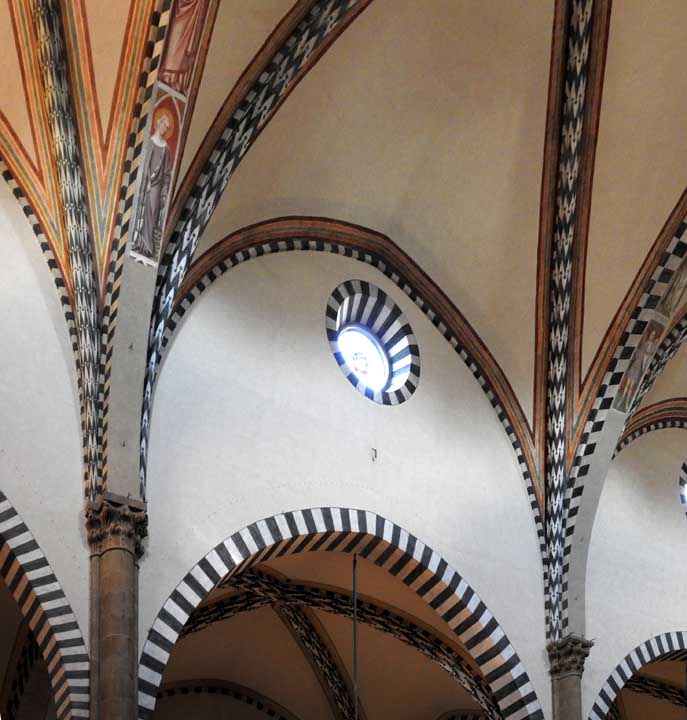 Pointed Gothic arches 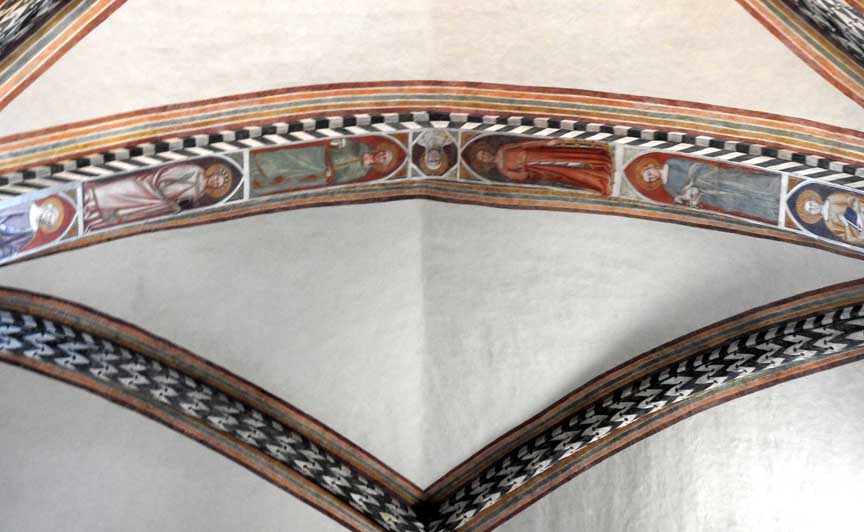 Decorated ceiling ribs  The vast interior is based on a basilica plan and is divided into a nave, two aisles set with windows and a short transept. ... Lower seating in photograph is in the aisle ... Photo taken from the Strozzi Chapel  The pillars that divide the aisles from the nave support pointed arches accented with a black and white pattern. 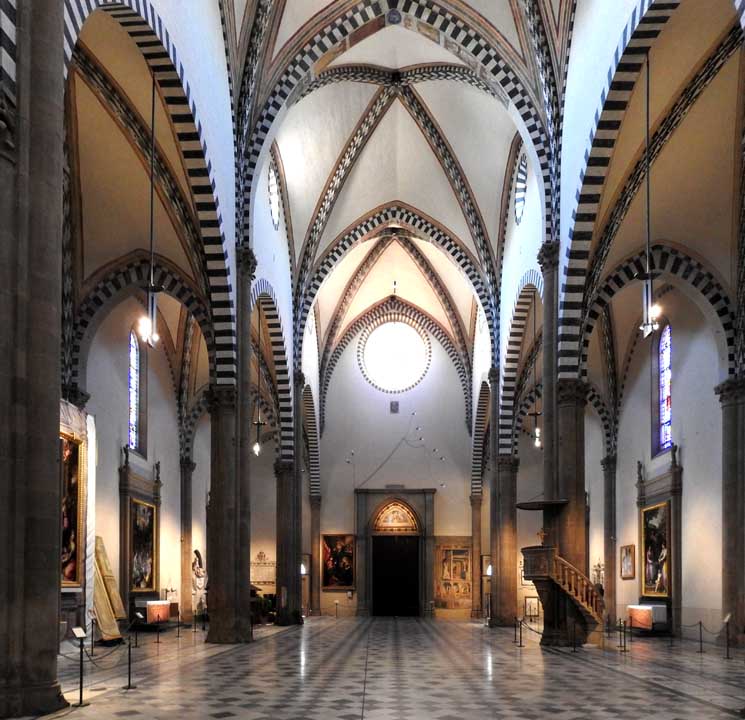 View toward back of church/front entrance ... The entire church was initially covered in frescoes but these were painted over in the 16th century by Vasari when he carried out massive works ordered by Cosimo de' Medici. ... Note round stained glass window above the portal - window detailed below: 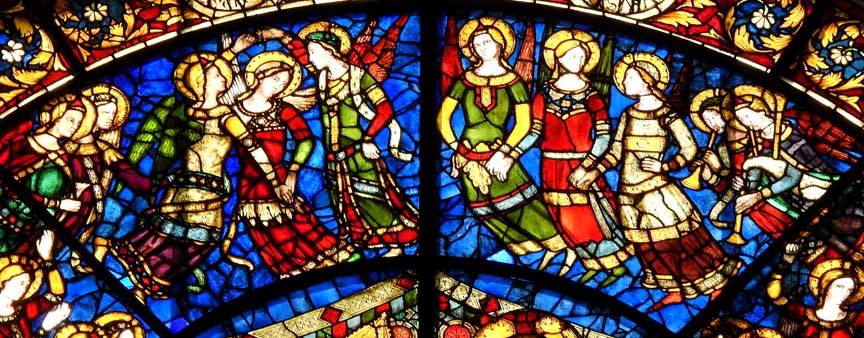 Stained glass Coronation of Mary in Heaven celebrated by angels playing musical instruments ... 14th century ... Based on a design of Andrea di Bonaiuto da Firenze 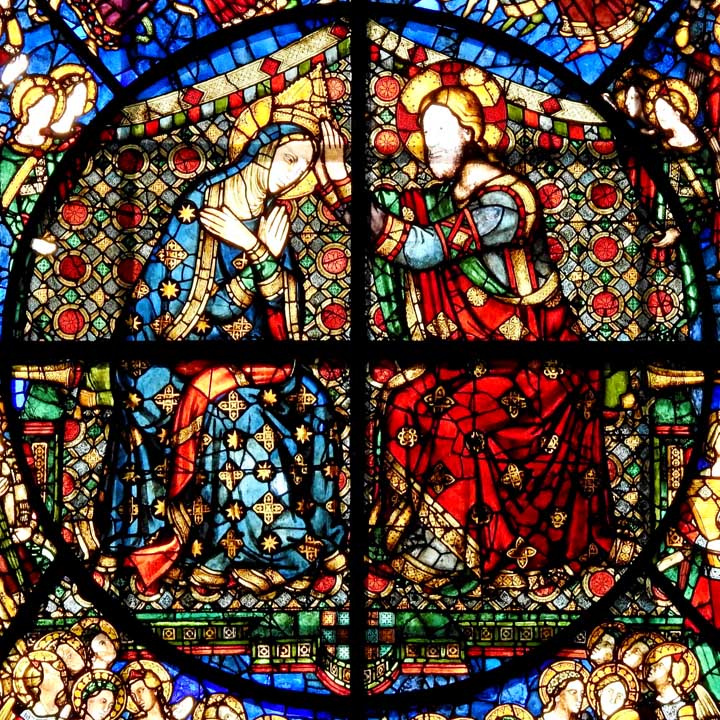 Coronation of Mary in Heaven 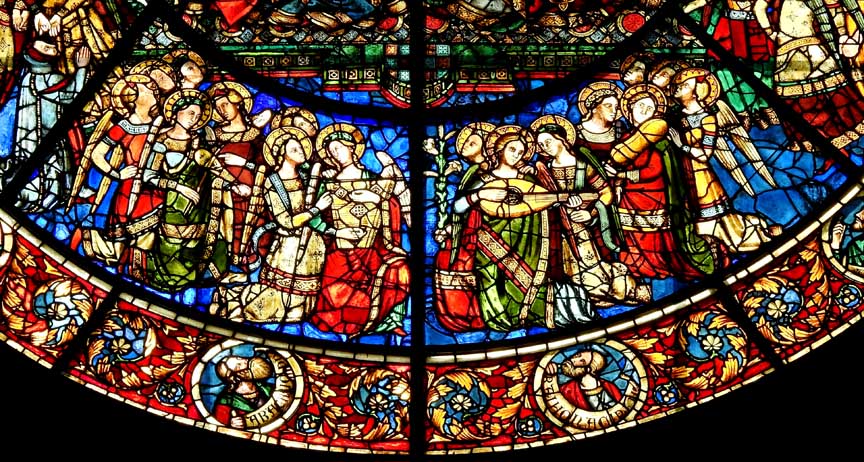 Coronation of Mary in Heaven celebrated by angels playing musical instruments |
| Rood Crucifix By Giotto 1288-89 Renaissance style "The
church initially was divided into two parts: the higher part closer to
the altar was divided by a wall and reserved for the friars while the
lower part was open to the faithful that entered by the eastern side
door. This wall was demolished by Vasari in the 16th century but you
can clearly see where the division used to be as Giotto's Crucifix
hangs right above.
The Crucifix by Giotto hangs in the center of the central nave as all his crucifixes were intended: with empty air all around it, you were to be reminded of Christ's actual crucifixion on the wooden cross. While it is an early work (1288-89) for Giotto, you can see his mastery in the shading on Christ's body, the waves in his hair, the blood spilling out, the details in the background tapestry. Gory but BEAUTIFUL at the same time!" - Visit Florence (online May 2020) 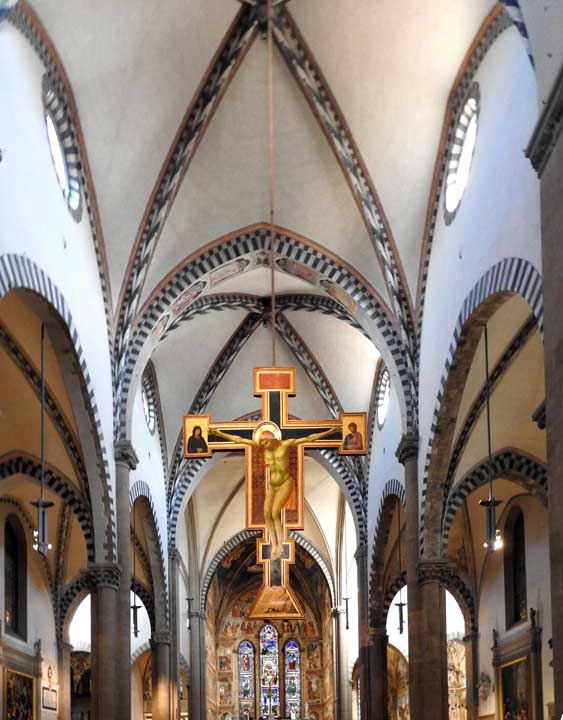 Rood Crucifix Leaving behind the stylized images of the Byzantine tradition, Giotto painted subjects true to life making him one of the earliest Renaissance artists. 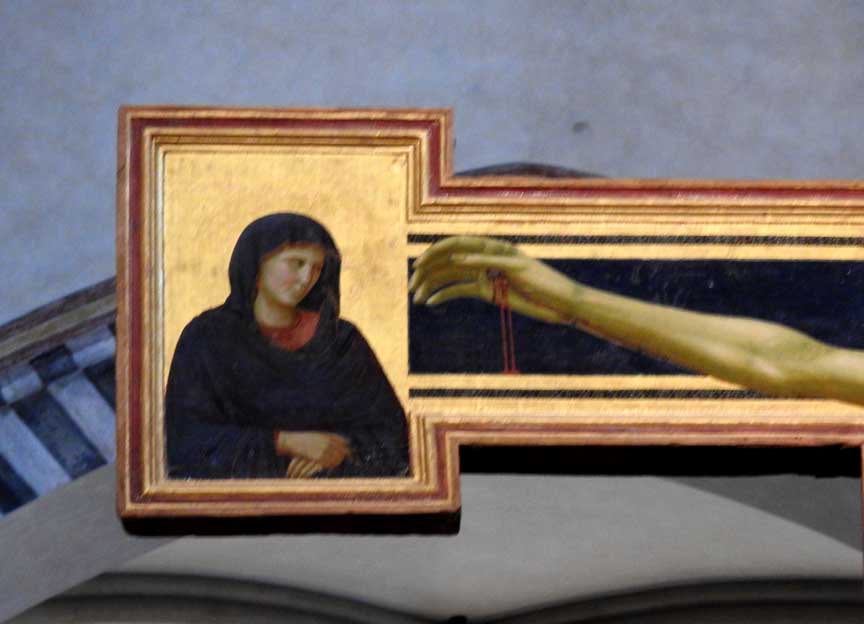 Rood Crucifix Mary, mother of Jesus, who was present at the Crucifixion ... Note one of the stigmata  Rood Crucifix St. John the Evangelist, also present at the Crucifixion 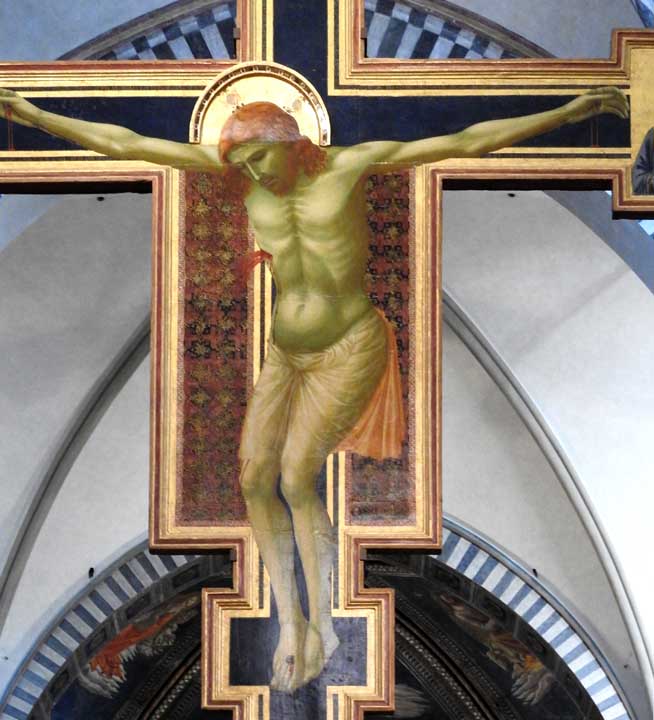 Rood Crucifix Note Renaissance realism  Rood Crucifix Gilded halo  Rood Crucifix One of the five stigmata  Rood Crucifix Two of the five stigmata 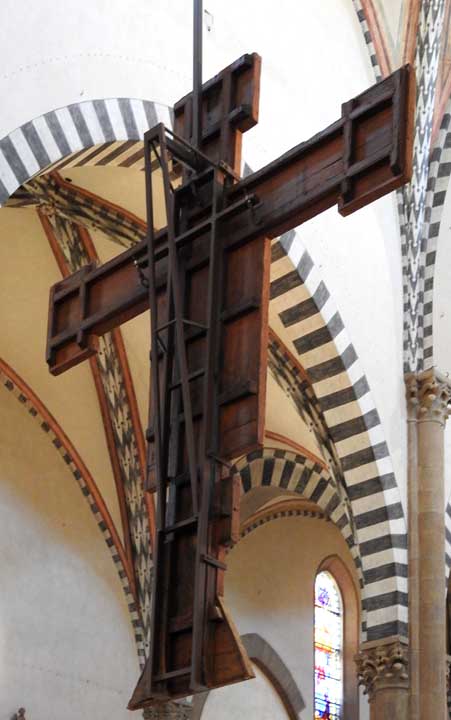 Rood Crucifix Crucifix back supports were not originally meant to be seen |
| St. Thomas Aquinas By Stefano di Ricco or Stefano Fiorentino C. 1450 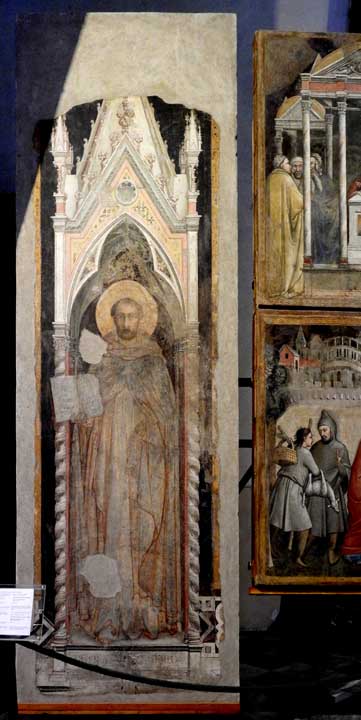 St. Thomas Aquinas Fresco ... Detached from the wall behind an altar in 1858 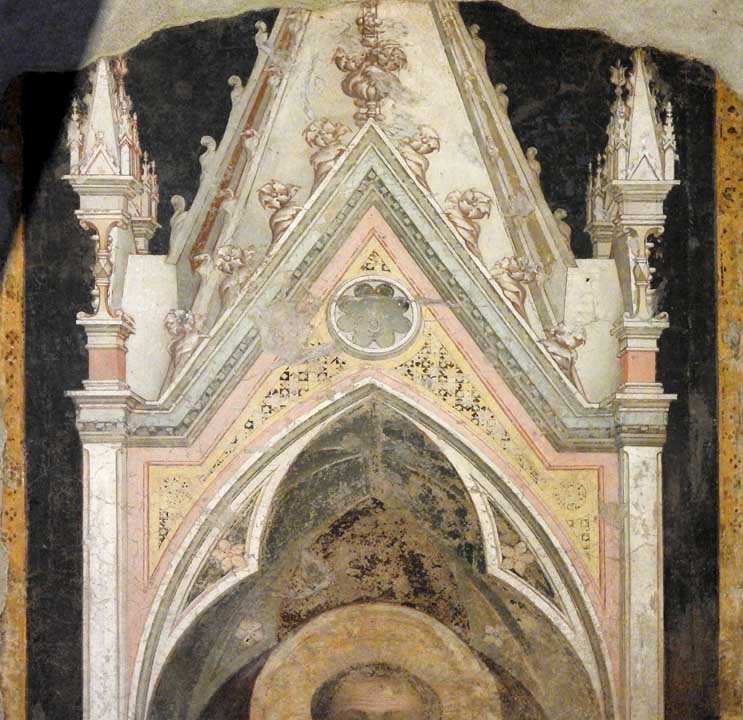 St. Thomas Aquinas Gothic architectural background ... Finials with pinnacles ... Crockets ... Multifoil ... Trefoil arch 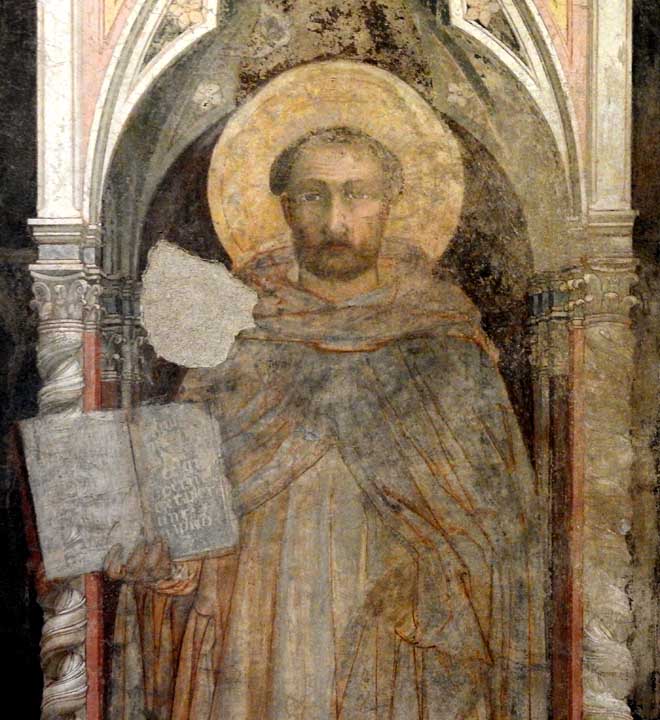 St. Thomas Aquinas Early Renaissance rendering of the saint |
Capella Strozzi di Mantova/ Strozzi Chapel Architects: Nardo Di Cione and Niccolo Di Tomasso C. 1360 Gothic style "Another
chapel
built for the Strozzi family is the
Cappella Strozzi di Mantova (Strozzi of Mantua Chapel). The
name refers to the city of Mantua, where members of the Strozzi family
lived after they were exiled from Florence.
"The chapel is decorated with frescoes by Nardo di Cione, who between 1351 and 1357 painted impressions of hell, purgatory and paradise. The frescoes were inspired by Dante's poem The Divine Comedy. Dante himself is depicted on the Paradise-fresco, together with members of the Strozzi family. Nardo di Cione also created the stained glass window with portraits of Mary and Thomas Aquinas." - A View on Cities  Strozzi Chapel  Strozzi Chapel Heaven mural, by Nardo di Cione 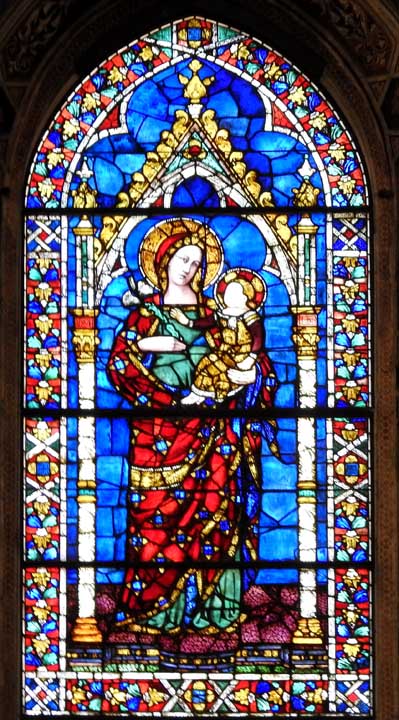 Strozzi Chapel Madonna and Child, by Nardo di Cione 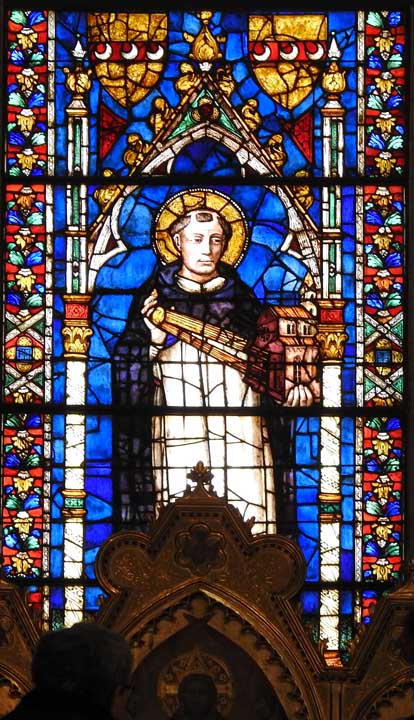 Strozzi Chapel St. Thomas Aquinas, by Nardo di Cione  Strozzi Chapel Altarpiece of the Redeemer, polyptych by Andrea Orcagna (Nardo's brother), 1357 ... Gilded background 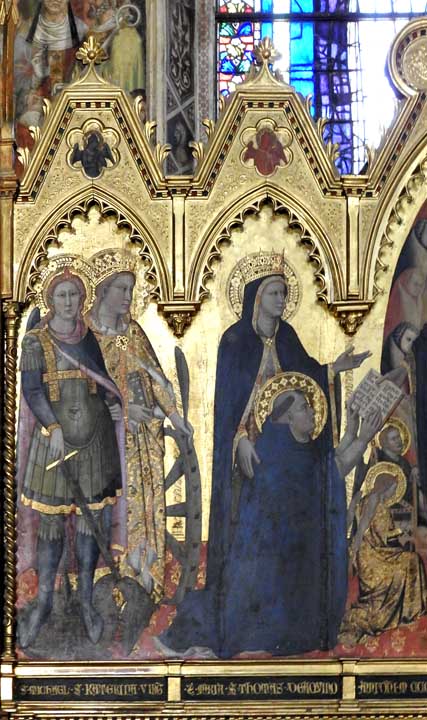 Strozzi Chapel Warrior Archangel Michael to the left of St. Catherine of Siena holding the wheel on which she was to be tortured ... Virgin Mary and St. Thomas Aquinas  Strozzi Chapel Jesus hands the Book of Knowledge to St. Thomas Aquinas and gives the key to heaven to Peter 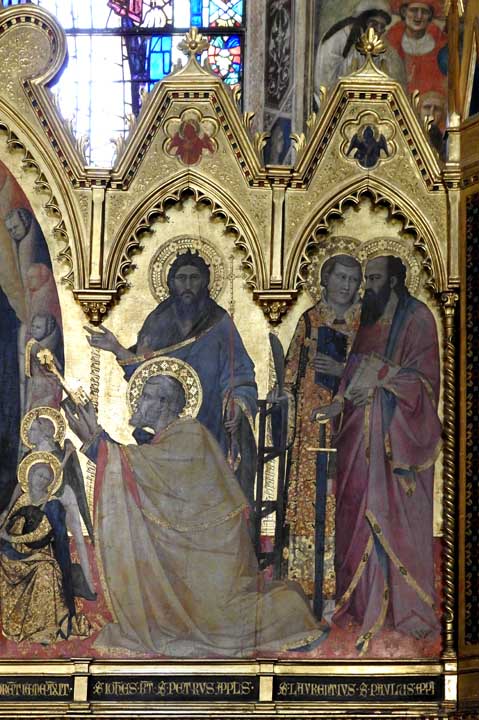 Strozzi Chapel Kneeling: St. Peter accepting the key to heaven |
Gondi Chapel - Crucifix By Brunelleschi Renaissance style "The
Gondi Chapel features a wooden crucifix created by Brunelleschi.
He carved the statue after Donatello had asked him what he thought of
the crucifix Donatello had made for Santa
Croce. Brunelleschi told him
his Christ looked like a buffoon. Donatello, insulted, told him to try
to carve a crucifix himself. Brunelleschi obliged and created his own
crucifix just to show Donatello how to do it properly. The chapel was
originally decorated with frescoes but in 1503 these were removed and
the chapel is now decorated with black and white marble panels."
- A
View on Cities (online
May 2020)
"The Gondi chapel to the left of the main altar contains a wooden Crucifix by Brunelleschi from 1410-15 which he completed in competition with his friend Donatello. Brunelleschi saw the crucifix Donatello had created for the Bardi Chapel in Santa Croce and was said to have exclaimed that Donatello's Christ looked like "a farmer on a cross" and said "I'll show you how Christ is supposed to be". He said that Christ was a man but not just any particular man and Brunelleschi then set out to show what he meant by that. The result is this Crucifix: carved in wood and then painted, observe the beautiful, majestic inclination of the head and the realistic detailed carving of the muscles in His body." - Visit Florence To the left of the main altar in the Gondi family's chapel is the recently restored Christ on the cross carved in wood by Brunelleschi in the early 1400's. The proportions are mathematically perfect following the rules of Vitruvius's ideal man and befitting the perfection of the subject according to Brunelleschi." - Walkabout (online May 2020)  Gondi Chapel - Crucifix  Gondi Chapel - Crucifix "The chapel was originally decorated with frescoes but in 1503 these were removed and the chapel is now decorated with black and white marble panels." 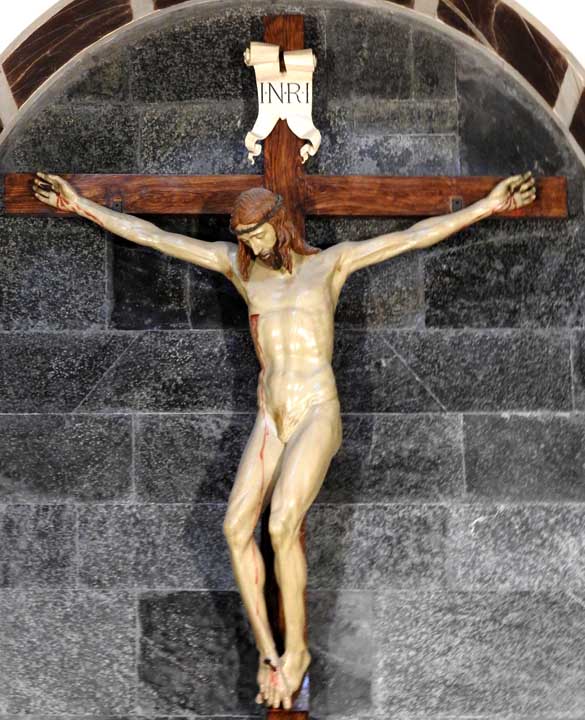 Gondi Chapel - Crucifix Carved and painted 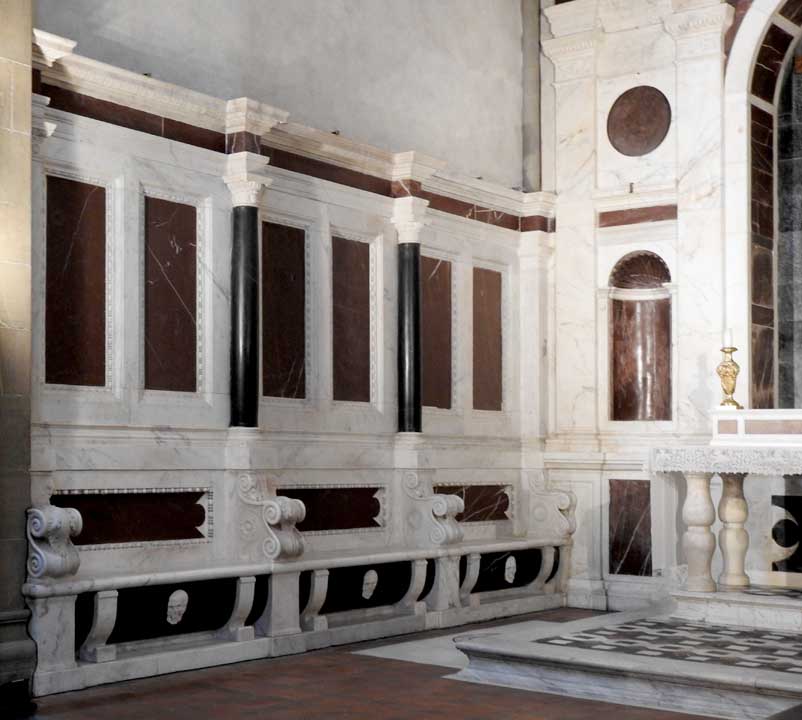 Gondi Chapel - Crucifix Marble S scrolls separate the seats |
| Martyrdom
of St.
Lawrence By Girolamo Macchietti 1573  Mannerist style oil painted altarpiece ... During the years 1556-1562, Macchietti worked as an assistant to Giorgio Vasari in the decoration of the Palazzo Vecchio. He participated in the Vasari-directed decoration of the Studiolo of Francesco I with two canvases, one relating a Jason and Medea (1570) and the other a Baths of Pozzuoli (1572).  Martyrdom of St. Lawrence Saint Lawrence was martyred by Roman Emperor Valerian in 258 ... Burned to death on a gridiron prepared with hot coals beneath it. After the martyr had suffered pain for a long time, the legend concludes, he cheerfully declared: "I'm well done on this side. Turn me over!" From this St. Lawrence derives his patronage of cooks, chefs, and comedians. ... Lawrence is especially honored in the city of Rome, of which he is considered the third patron after St. Peter and St. Paul. The Roman Catholic Church erected six churches on the sites in Rome traditionally associated with his martyrdom. ... In art, he is sometimes depicted with a gridiron. |
Frescoes on the back wall next to the main entrance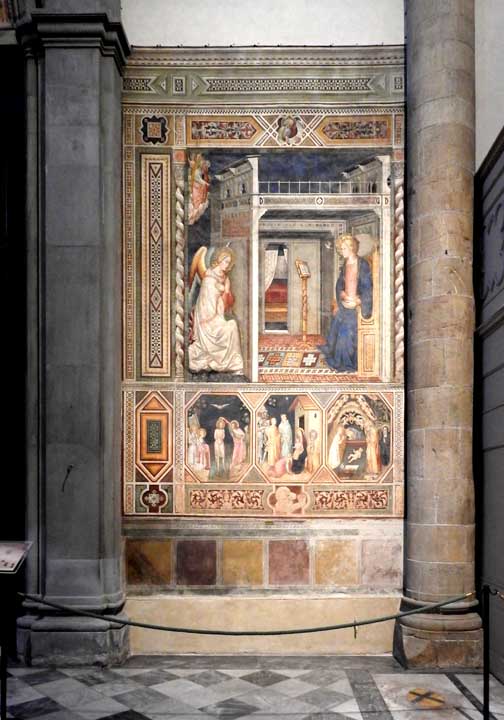 Frescoes on the back wall next to the main entrance 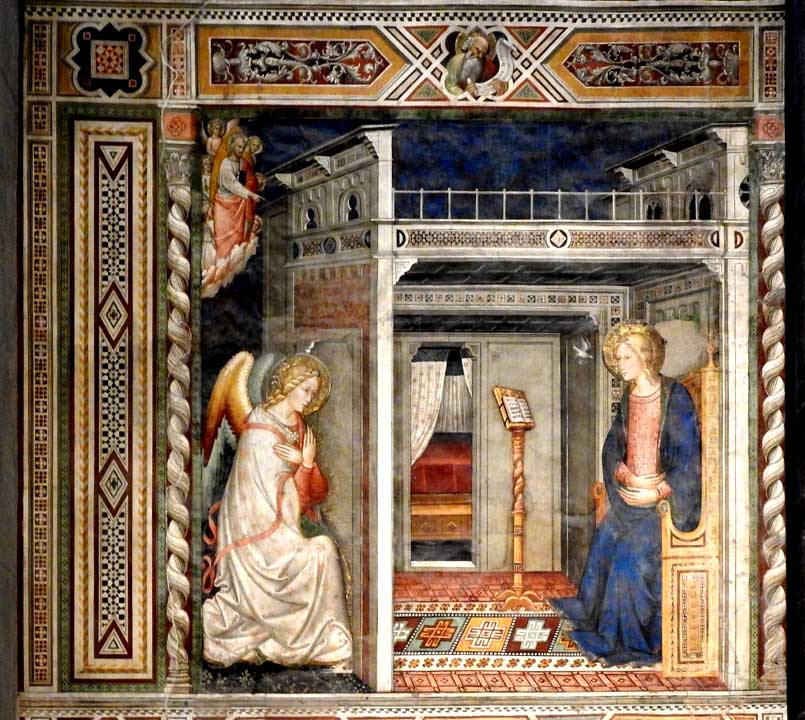 Frescoes on the back wall next to the main entrance The Annunciation  Frescoes on the back wall next to the main entrance John baptizes Jesus 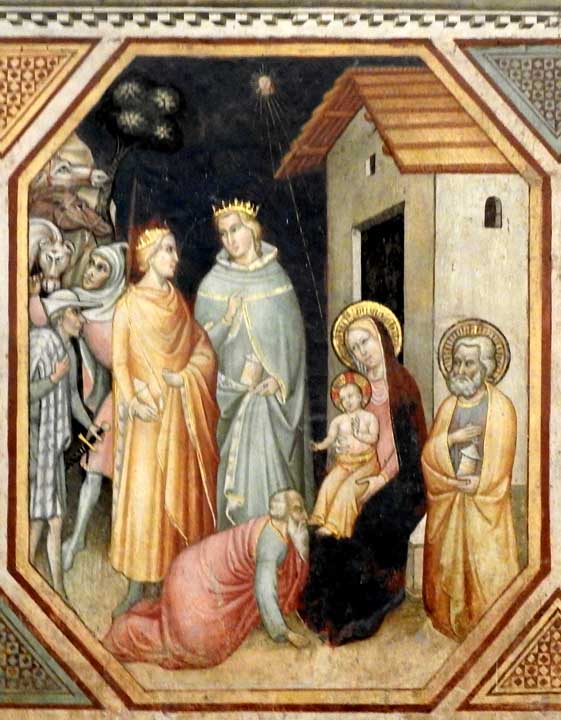 Frescoes on the back wall next to the main entrance Adoration of the Three Magi 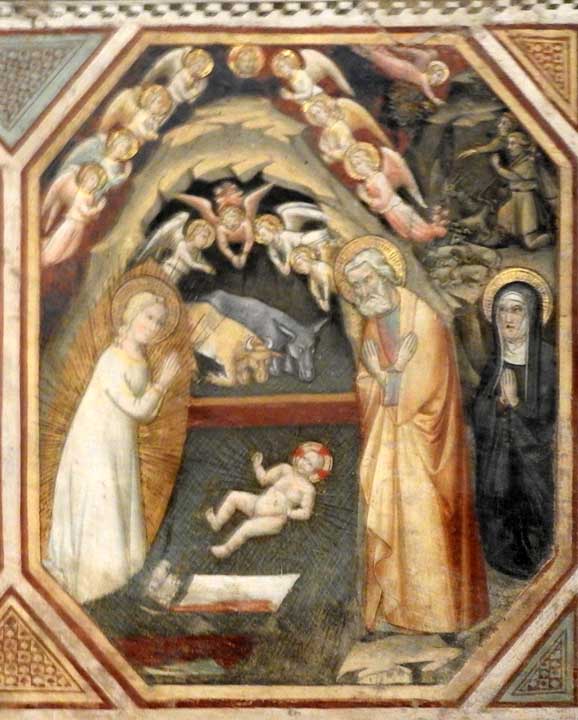 Frescoes on the back wall next to the main entrance Birth of Jesus |
| Trinity By Masaccio 1424-25 Renaissance style "The
Trinità,
or Trinity,
by Masaccio is on
the far
wall right in front of you as you enter the church through the side
door. The Trinità (1424-25) is one of the earliest paintings to
demonstrate mastery of perspective. Also notice that the Virgin Mary is
not portrayed as a young girl as in so many other paintings; here, she
is older and is clearly a mother.
"The entire church was initially covered in frescoes but these were painted over in the 16th century by Vasari when he carried out massive works ordered by Cosimo de' Medici. The Trinità was fortunately only covered by a massive painting and actually "rediscovered" around 1860 when further refurbishments were carried out." - Visit Florence (online May 2020) "... last known work of the artist, who died shortly thereafter, at only 27 years of age. Within the monumental classic architecture, God the father supports Christ’s cross. The figures of the painting’s sponsors kneel at the sides of the scene - an absolute novelty: never before had normal sized profane subjects been painted into sacred scenes. "The language is daring and revolutionary: for the first time the scene is presented with exceptional realism and is inserted into a grandiose painted scenario. The space, created in perspective, hit the eyes of the time as though it were real. Nothing like it had ever been seen before: the wall opened onto a sort of hole, revealing a bleak chapel done in an entirely new and different style. The Renaissance had begun to overtake the Gothic: modern times were knocking at the door." - Italy Guide Trinity Fresco ... Thought to be the earliest example of Renaissance style linear perspective, and almost certainly produced with the help of Brunelleschi. 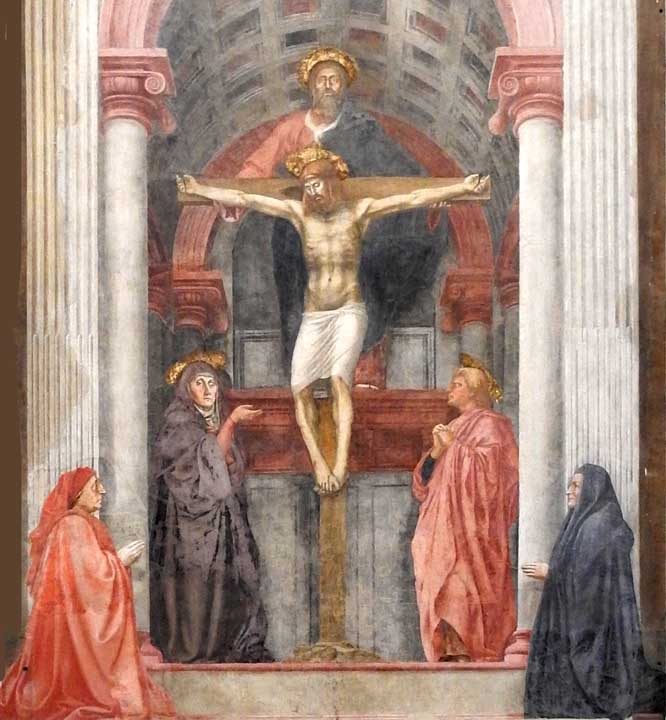 Trinity Madonna, St. John the Evangelist, two patrons of the Lenzi family below |
| St.
Lucia/St. Lucy 1494 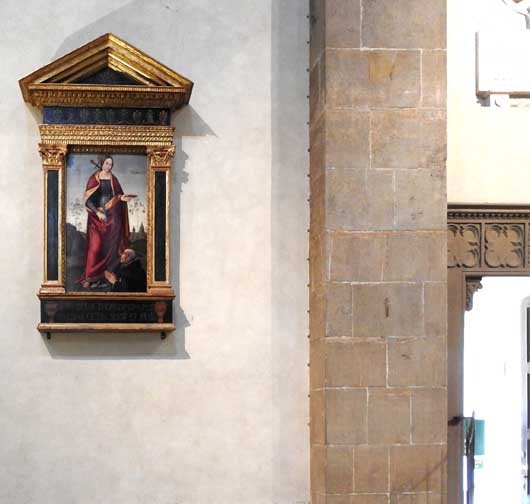 St. Lucia/St. Lucy  St. Lucia/St. Lucy Because Lucy refused to be married, she was tortured by having her eyes torn out. She was martyred by being stabbed with a dagger. She holds her eyes on a dish |